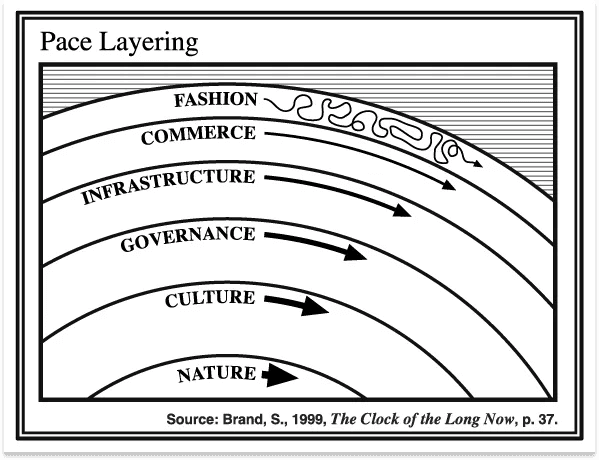The Long Game
Jul 18, 2024
A Guide to Seeing the Big Picture in a World of Constant Change
Something I've noticed among the minds of people I respect is their intense focus on the long term.
Most of us struggle to make sense of the world. We see new trends, new ways of making money, or shiny new technology and become enamored. But, suddenly, a new, shinier thing pops up, and we forget entirely about the idea that had us so enthralled just days before.
Great minds resist this, instead imposing the small movements they see onto much larger trends. How can we be more like them?
Pace Layers
One of the best frameworks I've found for long-term thinking is Pace Layers.

Pace Layers describe how complex systems learn and change by separating them into distinct layers, each with its own velocity and level of influence. The top layers move quickly, allowing for experimentation and new discoveries, while the bottom layers provide stability and direction.
In modern society, most of the shiny, new things that enamor us reside in the top layer, where our attention is intense but fleeting. This includes meme coins, TikTok trends, pop culture references, and new social platforms like Clubhouse and BeReal. Each of these had its moment of glory before quickly fading into irrelevance. However, occasionally, something in the top layer gains enough influence to push into the layer below. Instagram, for instance, slowly increased its relevance, starting as a simple photo-sharing site and growing into a full-blown social discovery platform by capitalizing on many of the trends in layers below it -- video sharing, direct messaging, social shopping, and more.
As ideas proliferate through paced systems, each layer acts as a filter, surfacing the best ideas to test their impact on the system. Through these tests, ideas gradually gain influence, pushing them into deeper layers and increasing their durability and lasting power.
Layered systems are present all around us. You can see them in nature, where a newly introduced organism can be quickly demolished by the environment controlling it or gradually take hold, changing and adjusting said environment based on its influence. They're present in our news cycles, where stories like Drake vs Kenrick last for a day, but the ongoing war in Gaza captures attention for months on end. You can find them in governments, where the constitution provides an unchanging source of stability and direction that informs the Bill of Rights, our lawmaking system, and each layer above it.
Understanding how these systems operate gives us a lens through which we can augment our own ways of thinking. When faced with an exciting new technology or trend, take a step back. Ask yourself, what trends in the layers below might influence this thing? Consider what technological advances might have happened or still need to happen for it to come to fruition.
In the blockchain space, owning, controlling, and profiting from your data is an exciting idea I often hear people discuss. However, while this sounds great in theory, it likely requires significant advancements in scale and throughput before it can be realized. In other words, there isn’t enough stability in the bottom layers for this idea to take hold — Not yet, at least.
And that’s the beauty of Pace Layers. Even though the layers may not be ready for a new idea to take hold, that doesn’t mean the idea is a wash. Ideas often flirt in and out of the experimentation layer, over and over, until finally, the right mix of stability, velocity, and attention lets them take off. Just look at how AI has blown up in the past three years after 50+ years of work and experimentation. Those 50 years slowly built up a base of knowledge, infrastructure, and consumer behavior that led to the perfect storm we see today. The stronger the base, the faster an idea can accelerate.
By thinking in Pace Layers, we can:
See how new trends and technologies fit within larger, slower-moving systems
Appreciate the interplay between fast-moving innovation and slow-moving wisdom
Build more resilient strategies in business, technology, and personal growth
The world isn't just getting faster — It's getting more layered, more interconnected. The layers are all around us. It’s time we opened our eyes and saw them.
More Posts